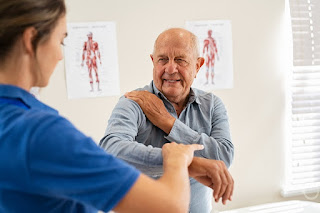Most people - men and women - experience myofascial pain syndrome at some time in their life, but it often goes undiagnosed.
Fascia is the thin, white connective tissue that surrounds muscle groups, blood vessels, and each of your organs inside your body. This tissue contains nerve endings but is not entirely understood. Healthy fascia is made up of layers with a liquid called hyaluronan between each. Fascia should stretch as you move. But it can become thick and sticky. When it dries and tightens around muscles, it limits your ability to move and can create painful knots. If you have myofascial pain, you feel pain and tenderness in certain muscles that often contain “trigger points”: small bumps or knots in the muscle tissue.
What Causes Fascia Pain?
Several major issues can cause smooth, slippery fascia to become gummy and crinkle up, adhering to muscle tissue:
- Repetitive movement that strains one muscle group
- Poor lifestyle involving little or no movement
- Trauma to the area caused by injury or surgery
- Working or living in cold temperatures
- Emotional stress
- Pinched nerves
Is It Myofascial Pain Syndrome or Fibromyalgia?Both fascial pain and fibromyalgia pain feel very much alike, but there are ways to differentiate the two. Myofascial pain usually involves one area or one side of the body. Fibromyalgia is felt all over, and patients have more trigger points, worse sleep problems, headaches, irritable bowel, a sensation of swelling, and at times burning, prickling, or tingling across their body. Who Treats Myofascial Pain?Several types of healthcare professionals are capable of treating the pain caused by muscle fascia. You may be referred to a physiatrist, pain management specialist, rheumatologist, or orthopedist, as well as a physical therapist. |
Other factors may contribute as well, including metabolic or hormonal problems, vitamin deficiencies, and/or chronic infection.
When Is It Fascia Pain?
You may mistake the pain you feel for muscle or joint pain. However, muscles and joints usually feel worse the more you move; fascia pain gets better with movement. It also improves with heat therapy. Trigger points can cause pain to occur during movement, when pressure is applied, and in seemingly unrelated body areas (known as “referred pain”).
Unfortunately, there’s no test to diagnose myofascial pain and no visible symptoms, such as redness or swelling. Your healthcare provider must physically examine your muscles and feel for constriction and trigger points.
Treatment Options
Relief for your pain will likely involve a combination of treatments, which fall into three broad categories.
- Medications include pain relievers such as ibuprofen (Advil and others) or naproxen sodium (Aleve). Your doctor could choose to prescribe something stronger that may come as a pill or patch. Antidepressants such as amitriptyline may tamp down your pain and have the added benefit of helping you sleep. Sedatives like clonazepam can treat anxiety and help you sleep, but they may be habit-forming.
- Physical therapies are both safe and effective. Using a hot pack or taking a warm shower can reduce pain. Massages can release muscle tension. Sound waves applied via ultrasound increase blood circulation and warmth. Light therapy with cold lasers may stimulate a release of pain-relieving chemicals in your bloodstream. Stretching exercises can also be very effective. A physical therapist may apply numbing solution on trigger points if you experience pain while gently stretching. TENS (transcutaneous electrical nerve stimulation) may be helpful.
- Needle procedures may be dry or wet. Inserting a thin needle in and around the trigger point (dry needling) may help release the contraction. Alternatively, needles may be used to deliver a numbing agent or steroid (wet needling) into the trigger point. Many fascial pain sufferers find acupuncture to be helpful.
No matter which combination of treatments you choose with the help of your doctor, exercise will be a vital component of your treatment plan. Yoga is often included for valuable stretching, but it is important to choose something you can continue. Meditation or journaling may help you relax. Try taking hot baths. Talk to friends or a counselor, or join a support group to help confront the challenge of myofascial pain. Finally, a healthy diet that is heavy on vegetables and fruits can help your body heal.
Sources:
Blog posting provided by Society of Certified Senior Advisors

